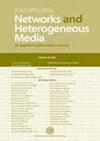A new model for the emergence of blood capillary networks
IF 1.3
4区 数学
Q3 MATHEMATICS, INTERDISCIPLINARY APPLICATIONS
引用次数: 0
Abstract
We propose a new model for the emergence of blood capillary networks. We assimilate the tissue and extra cellular matrix as a porous medium, using Darcy's law for describing both blood and interstitial fluid flows. Oxygen obeys a convection-diffusion-reaction equation describing advection by the blood, diffusion and consumption by the tissue. Discrete agents named capillary elements and modelling groups of endothelial cells are created or deleted according to different rules involving the oxygen concentration gradient, the blood velocity, the sheer stress or the capillary element density. Once created, a capillary element locally enhances the hydraulic conductivity matrix, contributing to a local increase of the blood velocity and oxygen flow. No connectivity between the capillary elements is imposed. The coupling between blood, oxygen flow and capillary elements provides a positive feedback mechanism which triggers the emergence of a network of channels of high hydraulic conductivity which we identify as new blood capillaries. We provide two different, biologically relevant geometrical settings and numerically analyze the influence of each of the capillary creation mechanism in detail. All mechanisms seem to concur towards a harmonious network but the most important ones are those involving oxygen gradient and sheer stress. A detailed discussion of this model with respect to the literature and its potential future developments concludes the paper.毛细血管网络出现的新模型
我们为毛细血管网络的出现提出了一个新的模型。我们吸收组织和细胞外基质作为多孔介质,使用达西定律来描述血液和间质液流动。氧气服从一个对流-扩散-反应方程,描述血液的平流,组织的扩散和消耗。根据不同的规则(包括氧浓度梯度、血流速度、绝对应力或毛细血管元件密度)创建或删除被称为毛细血管元件和内皮细胞建模组的离散因子。一旦创建,毛细血管元件局部增强液压传导矩阵,有助于局部增加血液速度和氧气流量。毛细管元件之间没有连接性。血液、氧气流动和毛细血管元素之间的耦合提供了一种正反馈机制,该机制触发了高水力传导性通道网络的出现,我们将其识别为新的毛细血管。我们提供了两种不同的、生物学上相关的几何设置,并对每种毛细管形成机制的影响进行了详细的数值分析。所有的机制似乎都朝着一个和谐的网络发展,但最重要的是那些涉及氧梯度和纯粹压力的机制。关于该模型的文献及其潜在的未来发展的详细讨论结束了本文。
本文章由计算机程序翻译,如有差异,请以英文原文为准。
求助全文
约1分钟内获得全文
求助全文
来源期刊

Networks and Heterogeneous Media
数学-数学跨学科应用
CiteScore
1.80
自引率
0.00%
发文量
32
审稿时长
6-12 weeks
期刊介绍:
NHM offers a strong combination of three features: Interdisciplinary character, specific focus, and deep mathematical content. Also, the journal aims to create a link between the discrete and the continuous communities, which distinguishes it from other journals with strong PDE orientation.
NHM publishes original contributions of high quality in networks, heterogeneous media and related fields. NHM is thus devoted to research work on complex media arising in mathematical, physical, engineering, socio-economical and bio-medical problems.
 求助内容:
求助内容: 应助结果提醒方式:
应助结果提醒方式:


